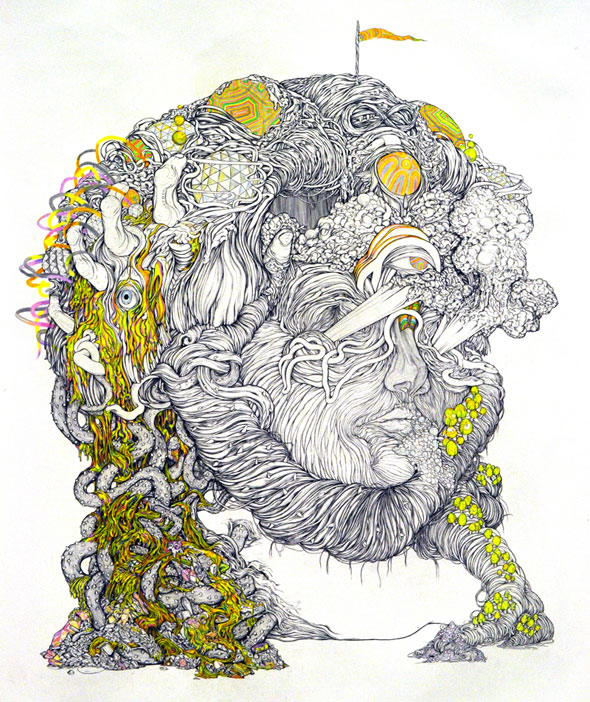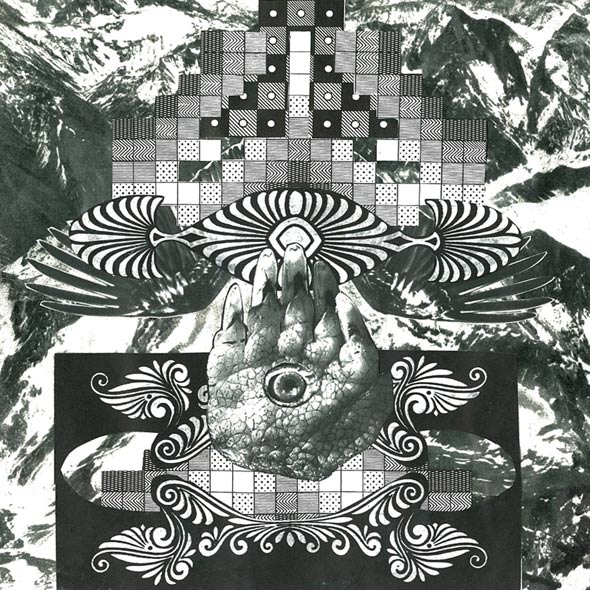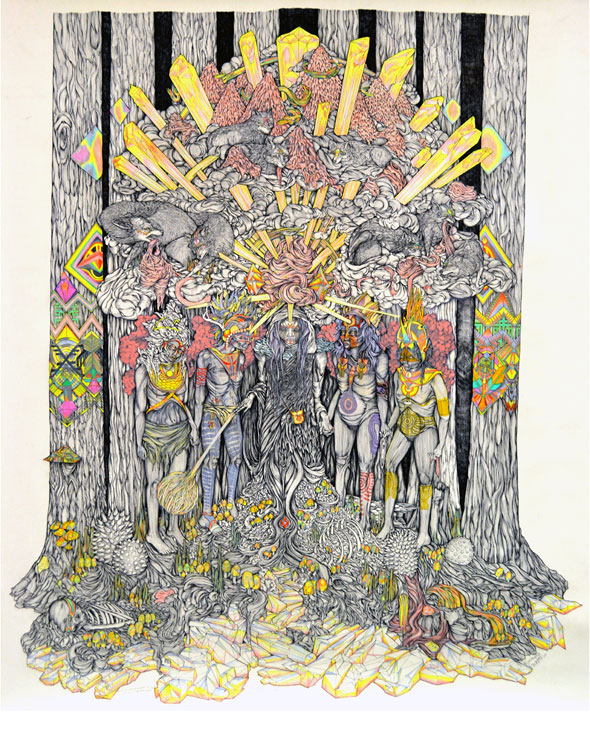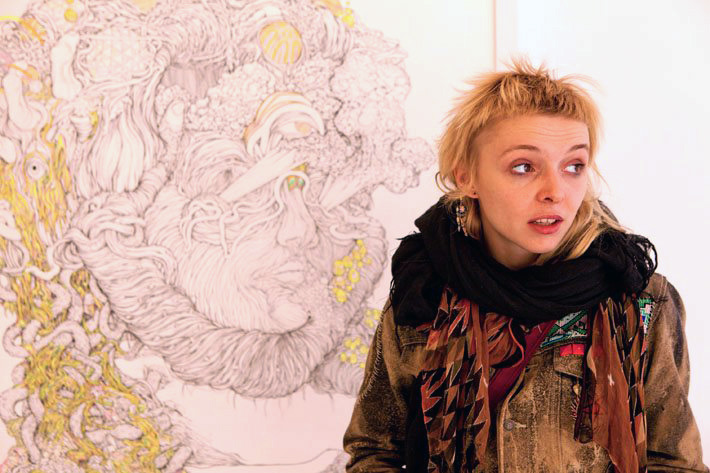We’re coming to the close of a great
retrospective
of Joe Sarno’s works at New York’s Anthology Film Archives, ending
September 26. Sarno was one of the sexploitation genre’s key auteurs,
and his films evoke the independent spirit of the underground film
movement — movies popularized during the ‘60s that pushed the boundaries
of technique and narrative with experimental artistry. These pictures
produced outside the commercial moviemaking industry ranged from the
subversive to the formless (at least where any story was concerned),
delighting in explicit subjects and exploring radical in-camera editing.
Crucial as he is, Sarno is just one of these 50 underground filmmakers
you should know.
 Jack Smith
Jack Smith
“The only person I would ever copy. He’s just so terrific, and I think he makes the best movies,”
said
Andy Warhol of underground filmmaking legend Jack Smith. The
influential fringe director challenged gender and sexual norms, and
introduced a controversial and delirious camp-trash aesthetic that has
been copied by artists and filmmakers like Mike Kelley and John Waters,
to name a few. Smith’s 1963 film
Flaming Creatures was ruled to be “obscene” and confiscated by the police during its premiere at New York’s Bleecker Street Cinema. Susan Sontag
described it as a “rare modern work of art; it is about joy and innocence.”
 Birgit Hein
Birgit Hein
Women are too often presented as the less-important halves of
filmmaking couples, but German writer-director Birgit Hein managed to
establish a presence apart from her frequent collaborator, husband
Wilhelm Hein. Several of her films broached the subject of collective
female anxiety. “That’s what’s interesting in these trash films — the
horror and prison films — they’re not reality,” Hein
stated
in a 1990 interview. “These films deal with dreams and somehow they are
true in a psychic way. If women can act like this in a film, it means
society also believes they can do that.”
 The Kuchar brothers
The Kuchar brothers
Twin prodigies George and Mike Kuchar produced a slate of inventive
8mm films during the ‘60s and ‘70s that caught the eye of underground
legends like Andy Warhol, Ken Jacobs, and Jonas Mekas. In an astute nod
to Hollywood’s Golden Era, the Kuchars employed a heady blend of
B-cinema, avant-garde narrative, queer-camp melodrama, and radical
social critique. George later produced a series of verité Hi8 video
diaries — a poignant record of his daily life. His best-known work,
Hold Me While I’m Naked, is an autobiographical portrait of a frustrated artist.
 Timothy Carey
Timothy Carey
“You can’t leave the film industry to the money people, they degrade it, they make people nothing,”
said wild-eyed filmmaker Timothy Carey. Better known for his astounding roles in John Cassavetes’
Minnie and Moskowitz and
The Killing of a Chinese Bookie, and Stanley Kubrick’s
The Killing and
Paths of Glory,
Carey cut his own path through ’60s cinema. Directing only a handful of
features, Carey made an indelible impression on the underground with
1962’s
The World’s Greatest Sinner (featuring a score from then
unknown Frank Zappa), which he also wrote, starred in, and produced. “I
was tired of seeing movies that were supposedly controversial. So I
wanted to do something that was really controversial,” he
said of
Sinner —
about an insurance salesman who grows tired of his mundane life, starts
a cult, appoints himself God, and starts a band. A taboo critique of
religion, politics, and middle-class America, Carey’s work was buried
for years by the “money people,” but his audience knows better.
 Bruce Conner
From LA Weekly
Bruce Conner
From LA Weekly‘s remembrance of the San Francisco found-footage pioneer:
A Kansas native who studied art at Wichita
University and eventually settled on the West Coast, Conner first
caused a stir in the gallery world in the late 1950s, with a series of
controversial assemblages (one of which, now in MoMA’s permanent
collection, featured a sculpture of a screaming child bound by nylon
stockings to a highchair). But it’s Conner’s film work—the subject of a
two-night retrospective co-presented by the UCLA Film & Television
Archive, REDCAT and Los Angeles Filmforum—that has cast the longest
shadow, spanning six decades, and stretching from Conner’s San Francisco
studio to the foothills of Hollywood. While future YouTubers were in
the womb (or not even a thought in their parents’ heads), Conner saw the
potential of throwaway images—movie countdown leaders, industrial
films, TV commercials, softcore porn—to be forged into dazzlingly
associative montages, rhetorical loops or subliminal blurs designed to
dance upon the audience’s subconscious. MTV, it has been said, might
never have existed without him.
 Sarah Jacobson
Sarah Jacobson
Jacobson’s underground splatter short
I Was a Teenage Serial Killer was featured in our
50 Essential Feminist Films list:
To me, feminism means that I should have
an equal opportunity to do what I want to do as a woman. I don’t want to
be better than men, I don’t want to shut men up. It’s like, look,
you’ve got your little thing over here, you’ve got your B-movie
aesthetic, and I’ve got my interpretation of it that girls can enjoy,
too, so you don’t always have to watch the bimbo get raped or slashed or
stalked or whatever.
Author of the progressive
S.T.I.G.M.A. Manifesto
(Sisters Together in Girlie Movie-Making Action), Jacobson left behind a
gender-busting DIY legacy that continues to empower independent
filmmakers.
 Kenneth Anger
Kenneth Anger
Before David Lynch featured Bobby Vinton’s “Blue Velvet” in his 1986
movie, Kenneth Anger used it in the groundbreaking 1963 film
Scorpio Rising — which toyed with notions of rebel worship and the Hollywood ideal through queer, occult imagery. “
Scorpio Rising
inaugurated innovative representations of same-sex desire through its
cinematic juxtaposition of such mass-mediated images. Moreover, its
montage often playfully foregrounds contradictory conceptions of
same-sex desire that continue to influence our thinking about sexuality
and identity today,”
writes the journal
Genders. Anger’s influence is incalculable. Provocative as ever, his website
greeting encapsulates the spirit of his work:
DESPITE INFLUENCING THE LIKES OF SCORSESE
AND LYNCH, THE GROUNDBREAKING CINEMA OF RENOWNED OCCULTIST KENNETH ANGER
HAS REMAINED UNDERGROUND FOR DECADES. DO YOU, FILM-WATCHER, HAVE MORAL
COURAGE? DO YOU HAVE INTELLECTUAL HONESTY? ARE YOU NOT UTTERLY BENT
SPIRITUALLY UNDER THE JUDEO-CHRISTIAN AMERICAN YOKE, JUICY PREY, LAMB OF
THE FOLD OF THE SLAVES OF THE SLAVE GODS? IN SHORT, IS THERE MANHOOD IN
YOU YET? THEN WATCH THESE FILMS, IF YOU WILL, AND MEET THE MOST
MONSTROUS MOVIEMAKER IN THE UNDERGROUND. MEET KENNETH ANGER.
 Herschell Gordon Lewis
Herschell Gordon Lewis
Known as the “Godfather of Gore,” Herschell Gordon Lewis’ assault on
good taste pioneered the splatter subgenre and established him as an
exploitation icon through a series of shocking, blood-soaked pictures.
1963’s
Blood Feast is considered the first gore film. Capturing
his images in lurid Eastmancolor, Lewis depicted gruesome acts with
cringe-worthy realism (using real animal organs for flesh-ripping
scenes). His work is also synonymous with various publicity stunts —
such as the “vomit bag,” which was handed to moviegoers upon entering
theaters.
 William Castle
William Castle
John Waters’ glowing
praise for B-movie legend William Castle (
House on Haunted Hill,
The Tingler,
13 Ghosts) is fun reading:
Without a doubt, the greatest showman of
our time was William Castle. King of the Gimmicks, William Castle was my
idol. His films made me want to make films. I’m even jealous of his
work. In fact, I wish I were William Castle. . . . William Castle was the best. William Castle was God.
 Paul Morrissey
Paul Morrissey
Bright Lights Film Journal founder Gary Morris wrote a must-read
essay on the work of Andy Warhol collaborator Paul Morrissey — one of the driving forces behind the Factory’s film output:
Much of the myth, if we can call it that,
surrounding Paul Morrissey comes out of his early relationship with Andy
Warhol’s Factory and its glittering, damaged denizens. In a world of
stylized weirdos, Morrissey was the straight businessman, always looking
for the commercial possibilities inherent in a scene where few believed
any existed. Viva called him “a real nine-to-fiver” and Warhol
biographer Stephen Koch said he was “an anomaly at the Factory.”
Morrissey’s drive and ambition made it possible for him to rework the
Warhol aesthetic evident in conceptually rich but unbearably dull
experiments like Sleep and Empire into more accessible, coherent, and
committed works like Trash, Heat, Mixed Blood, Blood for Dracula, and Women in Revolt.
The “great film achievements” of Warhol belong, for the most part, to
Morrissey, who wrote, produced, and directed them while Warhol
contributed no more than his name above the title.
 Melvin Van Peebles
Melvin Van Peebles
“
Sweet Sweetback’s Baadasssss Song gave us all the answers
we needed. This was an example of how to make a film (a real movie),
distribute it yourself, and most important, get paid. Without
Sweetback who knows if there could have been a
She’s Gotta Have It,
Hollywood Shuffle, or
House Party?”
said Spike Lee of director Melvin Van Peebles, father of actor and
New Jack City
director Mario Van Peebles. The elder Peebles wrote, produced, scored,
marketed, and starred in the groundbreaking 1971 film — which featured
an all-black cast and unsimulated sex scenes, and heralded a wave of
copycat movies, leading to the formation of the blaxploitation genre.
Repeatedly rejected by the studio circuit, Peebles financed the film
himself with help from Bill Cosby.
Storm De Hirsch
“I wanted badly to make an animated short and had no camera
available. I did have some old, unused film stock and several roles of
16mm. sound tape. So I used that — plus a variety of discarded surgical
instruments and the sharp edge of a screwdriver — by cutting, etching,
and painting directly on both film and tape,” poet and New York
avant-gardist Storm De Hirsch
told Jonas Mekas of her film
Divinations in a 1964 interview. Her written work and interest in Eastern esoterica informs her improvisational shorts.

Photo credit: Robert Carrithers
Scott B and Beth B
East Village No Wave figures Scott B and Beth B (and their pun-tastic
production company B Movies) achieved cult status through a series of
raucous 8mm shorts — “
savage satire on society’s distortions.” Their works caught the early attention of experimental film aficionados like J. Hoberman (who
called
them “space-age social realists” in 1979) and saw collaborations with a
veritable who’s who of New York artists: Richard Prince, Lydia Lunch,
and Bill Rice. Beth B. continued to make movies after parting ways with
Scott (noise-noir
Vortex is considered the last No Wave movie by many). She found modest mainstream success with the films
Salvation! and
Two Small Bodies.
 Shûji Terayama
Shûji Terayama
Prolific anarchist Shûji Terayama was a key figure in radical
filmmakers’ group the Art Theatre Guild and the founder of avant-garde
theater troupe Tenjo Sajiki — for which he was
praised by critic Akihiko Senda as being “the eternal avant garde.” 1971’s
Emperor Tomato Ketchup and 1974’s
Pastoral: Hide and Seek
found Terayama championing a post-adult world populated and ruled by
orgy-loving youths. Terayama also wrote the “runaway” movement’s
unofficial manifesto in
Throw Away Your Books, Rally in the Streets, a blistering adaptation of his own play.
 Jonas Mekas
The Guardian on
Jonas Mekas
The Guardian on “godfather of the avant-garde” Jonas Mekas:
Mekas is an integral figure in the history
of what used to be called underground cinema, not just as a film-maker,
but as a writer, a curator and a catalyst. In 1969, he helped set up
the Anthology Film Archives in New York, which houses the most extensive
library of experimental films in existence, and he has since overseen
the restoration of many classics of the form. His conversation is
peppered with the names of the more famous people he worked with in the
golden age of avant-garde film-making in the 1960s, from Yoko Ono to
Jackie Kennedy, Allen Ginsberg and the Beats to the Warhol set. Many of
these figures ended up in his films, which have in turn influenced the
likes of Jim Jarmusch, Harmony Korine, John Waters and Mike Figgis.
 Stan Brakhage
Stan Brakhage
Robin Blaetz’s
Avant-Garde Cinema of the Seventies essay is a nice primer on the time period for the uninitiated, with emphasis on the titan of experimental cinema, Stan Brakhage:
Stan Brakhage, who started making films in
the 1950s and is the best known and most prolific filmmaker of the
American avant-garde, continued his influential work throughout the
1970s. His signature first-person use of the camera, in which the
movement of the apparatus defines consciousness itself, was expanded
from documenting immediate perception to recording the filmmaker’s
encounter with memory and the world at large. Brakhage himself best
described his lifelong project in the opening lines of his
often-reprinted manifesto of 1963, entitled Metaphors on Vision:
“Imagine an eye unruled by man-made laws of perspective, an eye
unprejudiced by compositional logic, an eye which does not respond to
the name of everything but which must know each object encountered in
life through an adventure of perception…. Imagine a world before the
‘beginning was the word.” This union of body and camera that records the
very process of experiencing the world regardless of all established
codes of visual language is inherently documentary. Brakhage’s work as
an editor was to join and layer what he had discovered in the world, to
suggest in a single work of art the endless correspondences in and the
richness of perceptual experience. Since Brakhage’s films, which range
in length from minutes to many hours, manifest neither thematic unity
nor recognizable technique, they are virtually indescribable. However,
they reflect the concerns of the seventies to the degree that they use
the world as raw material, yet eliminate all recognizable imagery
through abstraction.
Ian Hugo
Watch Ian Hugo’s film
Bells of Atlantis, starring Hugo’s wife Anaïs Nin as the mythical narrator, reading from her dream-laden novella
House of Incest. The short features a score by electronic musicians Louis and Bebe Barron (
Forbidden Planet). Reminder: this was bloody weird stuff for 1952.
 Werner Schroeter
Film Comment on
Werner Schroeter
Film Comment on the queer German underground director (and nihilist fashionista!) Werner Schroeter:
Like his contemporaries Fassbinder,
Herzog, and Wenders, the late Werner Schroeter was one of the New German
Cinema’s seminal figures, if far more marginal in terms of recognition.
He started out as an underground filmmaker in 1967 before making a
critical impact on the international festival circuit and winning a
devoted cult following. His films, shot through with a predilection for
operatic excess and artifice, defy categorization, and are infuriatingly
obscure for some and entrancingly poetic for others. His cinema
occupies a transitional space between avant-garde and art cinema,
neither quite narrative nor quite abstract. In the second half of the
Eighties he became widely known as a theater and opera director, staging
a range of hyperstylized productions in Germany and abroad that
outstripped even his films in their ability to provoke both intense
admiration and hostility. His flamboyance and reputation for refusing to
compromise with the mainstream attracted outstanding talents willing to
work for little or no money, some of whom became his regular
collaborators. Foremost among the performers was Magdalena Montezuma,
the splendid German underground star and Schroeter’s muse until her
death in 1985. Subsequently French stars such as Bulle Ogier, Carole
Bouquet, and Isabelle Huppert gave him an additional art-house aura.
Throughout his career and thanks to major retrospectives, including
events in London, Paris, and Rome, Schroeter’s films kept garnering new,
if select, audiences.
 Bette Gordon
Bette Gordon
“Christine (Sandy McLeod) takes a job selling tickets at a porno
theater near Times Square. Instead of distancing herself from the dark
and erotic nature of this milieu, she develops an obsession that begins
to consume her life. Few films deal honestly with a female sexual point
of view, controversial and highly personal,
Variety does just
this,” writes IMDb of Bette Gordon’s best-known feature (1983). Gordon’s
work was born out of the downtown New York punk scene, and her
contributions to the feminist film milieu have been under-appreciated.
Here’s a nice little
intro to Gordon, written by the director, that focuses on her not-so-underground 2009 film
Handsome Harry.
 Christopher Maclaine
Christopher Maclaine
I highly recommend reading
these
1986 interview excerpts from thee Stan Brakhage on influential beat
filmmaker Christopher Maclaine, whose fascinating career ended
tragically after he was committed to an asylum:
Christopher was considered the Antonin
Artaud of North Beach, which was a fiercer place, I’d fancy, than Paris
was in Artaud’s time. North Beach was a place of great despair, World
War II despair. So many veterans came back and found the nation they had
gone to defend had eroded from their idealist viewpoints into the drive
for the almighty dollar—(in) the “booming” postwar period … This was a
great disillusionment. Many of them pitched into this despair — the
driving back and forth across the country, the drinking, or if they had
no money, just drinking and sitting in the gutter. Chris was one of the
first to read his poetry, often to jazz music, in bars to get his drinks
for the evening, or a meal. He had a few books of poetry in print, one
of which I’m fortunate to still have a copy of… I don’t know how in the
world he decided to make film because the lifestyle he led wouldn’t
usually enable him to do so. It wasn’t that he was that much of an
oddball — he was just the king of an accepted form of insanity… So
Maclaine made these four films (THE END, THE MAN WHO INVENTED GOLD,
BEAT, and SCOTCH HOP) in a burst of energy in the early ’50s,
culminating in THE END, which had its world premiere at Frank
Stauffacher’s Art in Cinema, where it precipitated a riot—not as violent
as some of the French riots, but there were certainly chairs thrown,
and people storming out or screaming for their money back.
 Stan Vanderbeek
Stan Vanderbeek
Vanderbeek’s surrealist collage film works (
Terry Gilliam,
eat your heart out) found him collaborating with an enviable group of
artists, including Claes Oldenburg, Yvonne Rainer, Merce Cunningham,
Allan Kaprow, and John Cage. “He called himself a technological fruit
picker,” curator Joao Ribas
said of the artist. Of his own aesthetic, Vanderbeek
wrote:
The technological explosion of this last
half-century, and the implied future are overwhelming, man is running
the machines of his own invention… while the machine that is man… runs
the risk of running wild. Technological research, development, and
involvement of the world community has almost completely out-distanced
the emotional-sociological (socio-“logical”) comprehension of this
technology. The “technique-power” and “culture-over-reach” that is just
beginning to explode in many parts of the earth, is happening so quickly
that it has put the logical fulcrum of man’s intelligence so far
outside himself that he cannot judge or estimate the results of his acts
before he commits them.
 Marie Menken
Marie Menken
“Willard and Marie were the last of the great bohemians. They wrote
and filmed and drank — their friends called them ‘scholarly drunks’ —
and were involved with all the modern poets,” Andy Warhol
said
of experimental filmmaking couple, the Menkens. The duo’s vital film
group Gryphon (established in the 1940s) saw the couple producing and
promoting experimental works, establishing an early foundation for
independent cinema. “Marie was one of the first to do a film with
stop-time. She filmed lots of short movies, some with Willard, and she
even did one on a day in my life,” Warhol also
declared.
“There is no why for my making films. I just liked the twitters of the
machine, and since it was an extension of painting for me, I tried it
and loved it,” Menken
said
in 1966. “In painting I never liked the staid and static, always looked
for what would change the source of light and stance, using glitters,
glass beads, luminous paint, so the camera was a natural for me to try —
but how expensive!”
 Russ Meyer
Russ Meyer
Roger Ebert
on friend and collaborator Russ Meyer (Ebert wrote the screenplay for 1970’s
Beyond the Valley of the Dolls) and what separated the sexploitation pioneer from his flesh-loving peers:
What Meyer’s films also have is an
uncommonly high level of artistry. In professional filmmaking circles,
Meyer is known as the one creative director in the sexploitation field.
His competitors churn out slipshod low-budget films exploiting the
nudity of their actresses (who usually look hideous enough to inspire
cries of “put it on!”). But Meyer budgets his films at around $70,000—or
10 times the usual level—and rehearses his cast for a month before
shooting. . . . His films are limited by their genre (familiarly known
as the “skin flick”) and by their budgets, but a consistent artistic
vision dominates them. They are fast-paced, usually well-acted, directed
with a joyous zest, and they deliver the goods.
 Ken Jacobs
Ken Jacobs
In his ’70s, Ken Jacobs made a nearly seven-hour film he started in the late 1950s,
Star Spangled to Death,
composed of found footage. “It pictures a stolen and dangerously
sold-out America, allowing examples of popular culture to self-indict.
Racial and religious insanity, monopolization of wealth and the
purposeful dumbing down of citizens and addiction to war oppose a Beat
playfulness,”
writes
the filmmaker of his 2004 movie. One look at Jacobs’ filmography shows
the tireless, now octogenarian director has made multiple films each
year since then. J. Hoberman’s
New York Times essay is a lovely introduction to Jacobs’ experimental contributions, which remain shockingly underrated.
 Kôji Wakamatsu
Kôji Wakamatsu
Kôji Wakamatsu has over 100 directorial credits to his name and is
best known for his confrontational and politically incendiary “pink”
softcore films. “Rape was a recurrent trope, usually in a metaphorical
role to represent patriarchal oppression and the US military’s
involvement in neighbouring countries on the Asian mainland,”
writes Jasper Sharp for the British Film Institute. In addition to directing violent “
eroductions” with evocative titles like
Go, Go Second Time Virgin and
Sex-Jack, the filmmaker’s Wakamatsu Pro company produced films like 1976’s
In the Realm of the Senses (1976) and 1971’s
Red Army PFLP: Declaration of World War, a propagandistic pro-Palestinian documentary.
 Gregory Markopoulos
Gregory Markopoulos
Not even a self-imposed exile during the ’60s kept the visionary
works of Gregory Markopoulos under wraps. The Harvard Film Archive
celebrates the films of the New American Cinema movement icon:
Gregory Markopoulos (1928-1992) was one of
the true visionaries of the post-WWII American avant garde. Across his
exquisitely stylized, oneiric early films and through his dazzling
master works of the late Sixties and Seventies, Markopoulos defined a
unique film language of incomparable formal rigor, visual beauty and
haunting lyricism. A tireless perfectionist, Markopoulos crafted a
unique mode of art cinema with an astonishingly minimum of funding and
resources—often editing his negatives by hand with only razor blade and
magnifying glass and perfecting in-camera editing techniques that
brought a poetic density to his films. Evident throughout his first
major films is a fascination with myth and ritual which would carry
across Markopoulos’ later work and would, eventually, call him back to
his ancestral Greece. The heady mythopoesis of key early films such as Swain and Twice a Man is also charged with a bold exploration of sexual and homosexual desire that was, in every way, far ahead of its time.
 Damon Packard
Damon Packard
Los Angeles filmmaker Damon Packard has been experimenting with film since the ‘80s, but his underground opus, 2002’s
Reflections of Evil
(a film he blew an inheritance on to create and in which he plays the
lead role), bridges a B-movie aesthetic with Hollywood formalism.
From Casey McKinney:
His heroes are serious, and for the most
part, mainstream filmmakers, people like Spielberg at his best moments.
And while he may be interested in the look of say Night Gallery,
it’s not for the kitsch value. Damon’s simulations of his favorite era
are move of a stripped down refinement of the period’s best
qualities—explorations of innovative camera techniques and analogue
attempts at recreating altered states of consciousness. To mime this
look, Damon employs the use of lens flares, slow motion, spot diffusion,
mirror props, kaleidoscopic filters, superimposition, and the warping
of film in order to produce a kind of fun house mirror effect. The
achieved result is simultaneously psychedelic and formalist.
 Diana Barrie
Diana Barrie
A student of Stan Brakhage (she often employed his hand-altered
techniques) and important figure in the male-dominated underground,
Diana Barrie’s clever, feminist reimaginings of mythical and religious
narratives (
My Version of the Fall) and boundary-pushing explorations of the female body (
Night Movie) deserve a wider audience. Unfortunately, her films are hard to find online, but she is sometimes lauded at film
festivals.
 Aldo Tambellini
Aldo Tambellini
I implore you to see any and all Aldo Tambellini exhibits you can find.
From James Cohan Gallery:
Iconoclastic and experimental artist Aldo
Tambellini was among the first artists in the early 1960s to explore new
technologies as an art medium. Tambellini combined slide projections,
film, performance, and music into sensorial experiences that he aptly
called “Electromedia.” Such work informed Andy Warhol’s Exploding
Plastic Inevitable and Woody and Steina Vasulka’s The Kitchen [a Chelsea
neighborhood art space established in the '70s]. With the rediscovery
of this material, Tambellini’s work has become the subject of great
interest for early new media.
 Kroger Babb
Kroger Babb
The most prominent member of the 40 Thieves, a circle of innovative
and money-minded American exploitation film distributors (the name was
well earned), Kroger Babb bridged the gap between art-house and
grindhouse. In addition to roadshowing sex-ed films from the ’30s, Babb
recut and distributed the titillating scenes in Ingmar Bergman’s
Summer With Monika (retitled:
Monika, The Story of a Bad Girl)
— which got him sued (although he got away with screening the film for
five more years). Babb also played mentor to sexploitation king David F.
Friedman, producer of seminal works in exploitation subgenres like
“roughies” (
The Defilers) and Nazisploitation (
Ilsa She-Wolf of the SS).
Jud Yalkut
Just when you thought the polka-dotted creations of Japanese artist Yayoi Kusama couldn’t be more psychedelic…
“One of the most influential filmmakers making experimental cinema in New York in the 1960s was Jud Yalkut,”
writes
film scholar Wheeler Winston Dixon. “Since then, Yalkut has gone on to
consolidate an enviable reputation as one of the most important
metamedia artists in American independent cinema.”
 Joe Sarno
Joe Sarno
Known as the “Ingmar Bergman of pornographic films,” Joe Sarno is
currently the subject of a retrospective at Anthology Film Archives that
will wrap up in mere days (run, don’t walk). “The writer and director
of literally dozens of low-budget erotic features targeted at the 1960s
‘adults only’ film market, Sarno is one of the true pioneers of
celluloid erotica and one of sexploitation’s most sincere and
critically-celebrated stylists,”
writes Anthology. Films like 1974’s
Confessions of a Young American Housewife
feature the typical swinger-style sexcapades from sexploitation
features of the period, but Sarno disarms audiences with a surprising
intimacy and emotion as a conservative homemaker explores her newfound
sexual freedom.
 Nick Zedd
Nick Zedd
“If it’s not transgressive, it’s not underground. It has to be
threatening the status quo by doing something surprising, not just
imitating what’s been done before.” —Nick Zedd
It will all make sense after reading the
Cinema of Transgression Manifesto. Watch some of the films from the movement on
UbuWeb.
 Pierre Clémenti
Pierre Clémenti
You’ll recognize Pierre Clémenti as Catherine Deneuve’s gangster lover in Luis Buñuel’s
Belle de jour,
but he collaborated with a number of visionary directors from the ‘60s
and ‘70s (Pasolini, Bertolucci, Visconti). An 18-month prison term and
drug charges tarnished his career, but he found acceptance in the French
underground film movement and made a movie with Warhol Superstar Viva.
 Shirley Clarke
Shirley Clarke
A peer of indie icons Maya Deren, Stan Brakhage, and Jonas Mekas,
Shirley Clarke’s provocative works dismantle the celluloid facade with
off-camera interjections from the director (see: her 1967 film about
gay, African-American performer Jason Holliday,
Portrait of Jason) and other voyeuristic techniques.
 Naomi Levine
Naomi Levine
Jonas Mekas championed the work of Warhol superstar Naomi Levine (
Kiss,
Batman Dracula), who eventually broke out on her own as a director with a 1964 film called
Yes.
“Naomi Levine has just finished her first movie. It is like no other
movie you ever saw. The rich sensuousness of her poetry floods the
screen. Nobody has ever photographed flowers and children as Naomi did,”
wrote
Mekas. “No man would be able to get her poetry, her movements, her
dreams. These are Naomi’s dreams, and they reveal to us beauty which we
men were not able to rip out of ourselves — Naomi’s own beauty.” From an
interview Mekas conducted with the filmmaker:
JM: Why did you make Yes?
NL: Because I wanted to make something beautiful.
JM: Why ‘something’ beautiful? Why not something perceptive — or of social consequence — or sexy?
NL: Beauty is all of these things. You
see, I went to Puerto Rico and made a demonstration at Rami Air Force
Base — and fifteen people lost their jobs and were beaten up and their
homes wrecked. So I realized that this was not the way. The way would be
to make something, to give something tot my world more beautiful and of
life than these armaments which are merely ugly and full of pain.
JM: Do you think you succeeded?
NL: That is impossible — maybe here and
there — maybe a glimmer, an instant of what I would like to give, of all
I experienced. So that I now know where to work from and toward, as a
whole. I know — after working with five versions and many editing
revisions, etc. — the world of Movie, the world of People, is the way
for me to go.
JM: How do you make your movies?
NL: Anything that happens on a set happens
— there is no ‘acting,’ no method to get what goes on. It’s real and it
has gone on for me forever. When I kiss I am kissed and I have kissed.
 Sogo Ishii
Sogo Ishii
The Japanese underground auteur, whose works like
Burst City
preceded the Japanese cyberpunk craze and have inspired Japanese
filmmaking greats like Takashi Miike, was featured in our list “
The 50 Weirdest Movies Ever Made.” “I’ve been making movies since I was 19 years old. My first film was shot on 8mm, it was called
Panic in High School. At the time it was very difficult for young people to make films in Japan,” Ishii
told
Midnight Eye. “It still is, in fact. Most directors are over 40, and
the normal process is to begin as an assistant director, then gradually
move on to directing. I didn’t want to be an assistant director and I
just started making films by myself. So yes, my way was different from
the usual way.”
 Lloyd Kaufman
Lloyd Kaufman
All you need to know about the co-founder Troma Entertainment and director of
The Toxic Avenger,
Class of Nuke ‘Em High, and
Terror Firmer can be found in his book,
All I Need to Know about Filmmaking I Learned from the Toxic Avenger. The New York City filmmaker is also chatty on
Twitter.
 Robert Downey Sr.
Robert Downey Sr.
From the man who brought us Robert Downey, Jr. comes cult classics such as
Putney Swope (a scathing satire of the advertising industry) and underground parodies like 1966’s
Chafed Elbows,
starring the director’s former wife, Elsie Downey, in every female
role. Downey captured most of the animated stills for the movie with a
35mm camera, the film of which he had processed at a drugstore. The
elder Downey’s humor was avant-garde for his time, and even his
bigger-budget projects, like
Greaser’s Palace, an acid western with a Christlike pimp as the main character, bristled the mainstream.
 Roger Corman
Roger Corman
The King of the Bs. A legend. Half of Hollywood owes its career to
Roger Corman (James Cameron, Jack Nicholson, and Martin Scorsese all got
their start with him). Essential reading:
How I Made a Hundred Movies in Hollywood and Never Lost a Dime.
 Radley Metzger
Radley Metzger
Adult cinema pioneer Radley Metzger injected an art-house
aesthetic into his literary-inspired sexploitation productions:
Hoping to cash in on Europe’s sexploitation canon in 1960’s America, Metzger began importing and distributing erotica (The Fast Set, The Twilight Girls, I, a Woman), which led to his sexploitation directorial debut — 1965’s The Dirty Girls.
Metzger’s take on the genre was slick, sexy, and glamorous —
productions that felt closer to art films or high-fashion photo shoots
than smut. The locations were exotic, the women seductive, and Metzger’s
compositions striking—but the filmmaker never veered away from
controversial subjects.
 Hollis Frampton
Hollis Frampton
Criterion’s 2012 Blu-ray release,
A Hollis Frampton Odyssey, is a beautiful bible of the structuralist filmmaker’s work:
An icon of the American avant-garde,
Hollis Frampton made rigorous, audacious, brainy, and downright
thrilling films, leaving behind a body of work that remains
unparalleled. In the 1960s, having already been a poet and a
photographer, Frampton became fascinated with the possibilities of 16mm
filmmaking. In such radically playful and visually and sonically
arresting works as Surface Tension, Zorns Lemma, (nostalgia), Critical Mass, and the enormous, unfinished Magellan
cycle (cut short by his death at age forty-eight), Frampton repurposes
cinema itself, making it into something by turns literary, mathematical,
sculptural, and simply beautiful—and always captivating.
 Abel Ferrara
Abel Ferrara
Ferrara straddles two worlds. At his grittiest and goriest, he found a cult audience in the downtown underground (
Driller Killer,
Ms. 45). But Ferrara is also one of the rare underground filmmakers to find acceptance with mainstream audiences and critics (
Bad Lieutenant). Ferrara has refuted the underground label. “I’m a college-educated white boy. I eat at Morton’s with the other guys,” he
told New York Magazine in 1993.
Ms. 45 star Zoë Lund called him a “junkie-voyeur,”
observing:
“He likes to surround himself with people from the criminal element
because he wants to get a peek behind the curtain, and he doesn’t want
to pay for it.” That dichotomy lends a fascinating tension to his work,
but has also stigmatized his career.
 The Vienna Actionists
The Vienna Actionists
The transgressive, violent, and political films of the experimental
Viennese Actionists make the most daring of directors look like
pussycats. The films acted as a documentation of the movement’s
performative works, but are singular works of art in their own right. An
article in Issue 84 of
Frieze explains
the group’s trajectory and how these challenging artists (Kurt Kren,
Otto Mühl, and company) are perceived in their home country today.
 Jörg Buttgereit
Jörg Buttgereit
Best known as “that guy who made those films about necrophilia,”
maverick moviemaker Jörg Buttgereit’s experimental film career started
in the 1970s with a series of satirical shorts. He became known for his
radical avant-garde, nihilistic examinations of depravity and social
consciousness (the
Nekromantik series and
Der Todesking).
 Harry Everett Smith
Harry Everett Smith
New York City beat scenester, oddball collector, mystic, and former
Hotel Chelsea resident Harry Everett Smith makes George Lucas look
slightly less obsessed. His surreal animations, featuring hand-painted celluloid, made the editing rounds more times than
Star Wars.
Smith’s patchwork, improvisational approach to filmmaking resulted in
wild experimentation. He was also a beautiful weirdo, as website Harry
Smith PDX vouches for with
this story: “He created elaborate customized equipment to project his last major film,
Mahoganny, and then threw it out the window.”
 Doris Wishman
Doris Wishman
“
Nudie-cutie”
filmmaker Doris Wishman infiltrated a guy’s club of sexploitation
cinema in the 1960s with her titillating nudist camp “documentaries” and
low-budget softcore pictures. Wishman’s work can hardly be described as
feminist, but she was an astute businesswoman and prolific filmmaker
who wrote, shot, edited, and produced her own work.
 Curtis Harrington
Curtis Harrington
The Harvard Film Archive
on actor, director (he even gave us psycho-biddy classics like
Whoever Slew Auntie Roo? and
What’s the Matter with Helen?), film critic, and new queer cinema pioneer Curtis Harrington:
Marginalized by film historians and
largely overlooked during his lifetime, the late Curtis Harrington
(1928-2007) was a key figure in the West Coast experimental film scene
and among the most wholly original directors to work in the Hollywood
studio system. An ardent cinephile since his earliest years, Harrington
began his film career as an errand boy at Paramount and eventually
became a successful A-list director at Universal in the 1960s. An early
protégé of Maya Deren and a close friend of Kenneth Anger and Gregory
Markopoulos, Harrington’s first works were poetic trance films that
revealed his careful eye and distinctive style. During his youth
Harrington also befriended two of his greatest idols, iconoclastic
studio directors James Whale and Joseph Von Sternberg, uncompromising
aesthetes whose refined—and at times, perverse— tastes and wicked sense
of humor would remain major influences on all of Harrington’s major
films. This series pays tribute to an artist who never lost sight of his
youthful ideals and produced a dazzling body of work ripe for
rediscovery.
 Kazuo Hara
Kazuo Hara
Japanese documentary director Kazuo Hara’s films were confrontational
in ways that presaged the obsessive docs of Errol Morris and Werner
Herzog. His guerrilla-style filmmaking and exploration of forbidden
subjects was revolutionary, intuitive, and provocative. In
The Emperor’s Naked Army Marches On,
he chronicled war crimes committed by Japanese soldiers in occupied New
Guinea during World War II. The story is told through the impassioned
investigation of a veteran who blamed the atrocities on Emperor Hirohito
(a taboo accusation in Japanese society). His first feature,
Goodbye CP (1972), is a challenging look at shunned Japanese men and women with cerebral palsy, while 1974’s
Extreme Private Eros is a confessional, relentless documentary centered on Hara’s relationship with his feminist lover Takeda Miyuki.
 José Rodriguez-Soltero
José Rodriguez-Soltero
J. Hoberman
on queer and Latino New York underground film icon José Rodriguez-Soltero, whose 1966 ode to Lupe Vélez,
Lupe, is often neglected when mentioning the greats from the counterculture:
Rodriguez-Soltero was in his twenties, under the influence of Flaming Creatures and early Warhol, when he made these two exercises in super-saturated Kodachrome II thrift-shop glamour. Jerovi
is a silent 10-minute study of a young dude who sheds his form-fitting
brocade outfit—but not the red, red rose that he’s clutching—for some
passionate al fresco onanism. This “sexual probe of the Narcissus myth,”
per the filmmaker, was banned from the 1965 Ann Arbor Film Festival but
wound up cited by Jonas Mekas as one the year’s best movies.
Thus encouraged, Rodriguez-Soltero
embarked on a follow-up homage to Hollywood’s “Mexican Spitfire,” Lupe
Vélez, whose suicide is graphically detailed in Kenneth Anger’s Hollywood Babylon.
It was during the nine months that Lupe was in production that
Rodriguez-Soltero staged his infamous LBJ at the Bridge Theater on St.
Marks Place. Accompanied by the martial beat of America’s No. 1 song,
“The Ballad of the Green Berets,” the filmmaker set fire to an American
flag. (According to reporter Fred McDarrah, “The impact on the audience
was sensational”: The event got a full-page spread in the next week’s Voice.)






 After quitting
After quitting 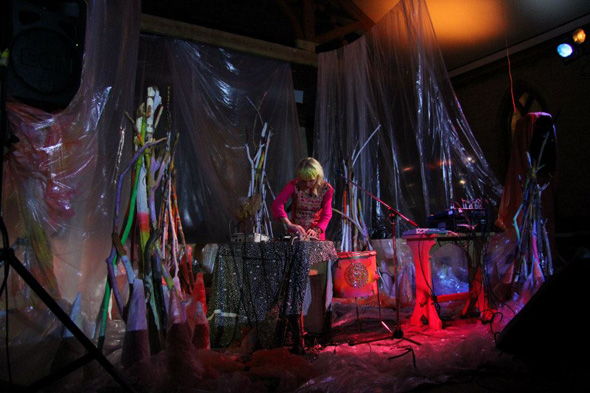 How would you describe Petra Glynt, and where did the project come from? How much does it tie in with your visual work?
How would you describe Petra Glynt, and where did the project come from? How much does it tie in with your visual work? The 4-track demos on your Bandcamp are rough, but full of feeling and technique. They remind me of some weirder
The 4-track demos on your Bandcamp are rough, but full of feeling and technique. They remind me of some weirder 